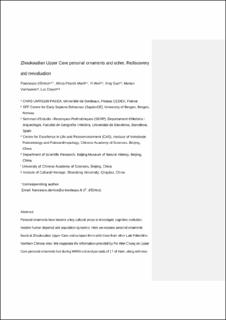| dc.contributor.author | d'Errico, Francesco | |
| dc.contributor.author | Pitarch Martí, Africa | |
| dc.contributor.author | Wei, Yi | |
| dc.contributor.author | Gao, Xing | |
| dc.contributor.author | Vanhaeren, Marian | |
| dc.contributor.author | Doyon, Luc | |
| dc.date.accessioned | 2022-03-21T13:59:45Z | |
| dc.date.available | 2022-03-21T13:59:45Z | |
| dc.date.created | 2021-12-02T14:53:15Z | |
| dc.date.issued | 2021 | |
| dc.identifier.issn | 0047-2484 | |
| dc.identifier.uri | https://hdl.handle.net/11250/2986567 | |
| dc.description.abstract | Personal ornaments have become a key cultural proxy to investigate cognitive evolution, modern human dispersal, and population dynamics. Here, we reassess personal ornaments found at Zhoukoudian Upper Cave and compare them with those from other Late Paleolithic Northern Chinese sites. We reappraise the information provided by Pei Wen Chung on Upper Cave personal ornaments lost during World War II and analyze casts of 17 of them, along with two unpublished objects displayed at the Zhoukoudian Site Museum and three original perforated teeth rediscovered at the Zhoukoudian Site Museum. We apply archeozoological, technological and use-wear analyses to document variation in ornamental practices and their change throughout the site stratigraphy. Badger, fox, red deer, sika deer, marten, and tiger teeth as well as carp bone, bird bone, Anadara shell, limestone beads, and perforated pebble appear to have been the preferred objects used as ornaments by Upper Cave visitors. Multivariate analysis of technological data highlights a correspondence between cultural layers and perforation techniques, with radial incising being typical of layer L2 and bidirectional incising of L4. The three rediscovered badger canines display features suggesting they were sewed on clothing rather than suspended from necklaces or bracelets. Elemental scanning electron microscopy coupled with energy dispersive X-ray spectromety and mineralogical (μ-Raman) analyses of red residues adhering to the rediscovered teeth indicate these objects were originally coated with ochre and identify variations that match differences in technology. The two ornaments exhibited at the Zhoukoudian Site Museum are ancient teeth that were recently perforated and should be excluded from the Upper Cave assemblage. A seriation of Late Paleolithic ornaments found at Northern Chinese sites identifies a clear-cut difference in preferred ornament types between western and eastern sites, interpreted as reflecting two long-lasting traditions in garment symbolic codes. | en_US |
| dc.language.iso | eng | en_US |
| dc.publisher | Elsevier | en_US |
| dc.rights | Attribution-NonCommercial-NoDerivatives 4.0 Internasjonal | * |
| dc.rights.uri | http://creativecommons.org/licenses/by-nc-nd/4.0/deed.no | * |
| dc.title | Zhoukoudian Upper Cave personal ornaments and ochre: Rediscovery and reevaluation | en_US |
| dc.type | Journal article | en_US |
| dc.type | Peer reviewed | en_US |
| dc.description.version | acceptedVersion | en_US |
| dc.rights.holder | Copyright 2021 Elsevier | en_US |
| dc.source.articlenumber | 103088 | en_US |
| cristin.ispublished | true | |
| cristin.fulltext | postprint | |
| cristin.qualitycode | 2 | |
| dc.identifier.doi | 10.1016/j.jhevol.2021.103088 | |
| dc.identifier.cristin | 1963569 | |
| dc.source.journal | Journal of Human Evolution | en_US |
| dc.relation.project | Norges forskningsråd: 262618 | en_US |
| dc.identifier.citation | Journal of Human Evolution. 2021, 161, 103088. | en_US |
| dc.source.volume | 161 | en_US |

